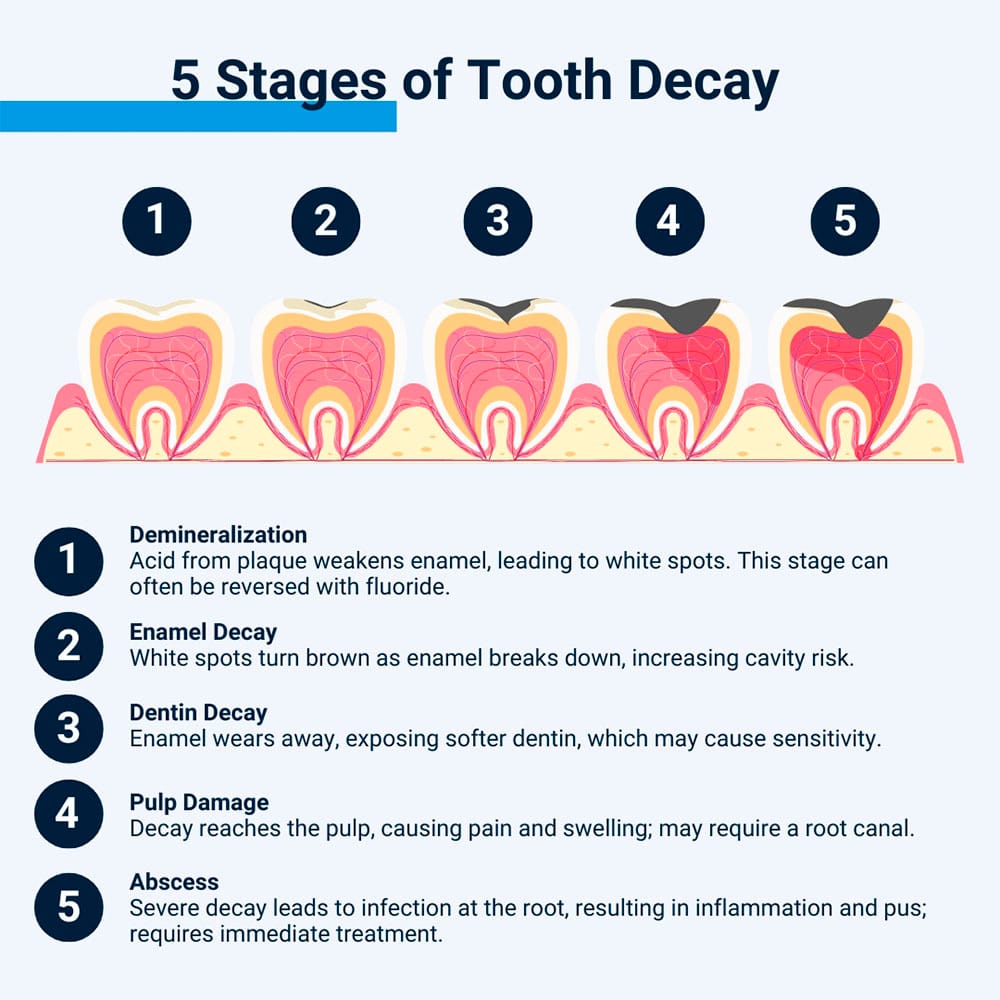What Is Tooth Decay?
Tooth decay occurs when a tooth has a hole or cavity. You may develop a cavity if tooth enamel becomes damaged or eroded. Anyone can develop tooth decay; once a cavity begins, it must receive professional dental care. Otherwise, the decay will continue, eventually requiring more extensive and invasive dentistry such as root canal therapy.
How Does a Cavity Form?
A cavity can begin forming when your tooth enamel is gradually eroded or damaged. Tooth decay usually occurs because of lax oral hygiene, where bacteria in dental plaque and old food particles are not removed regularly and thoroughly.
These bacteria feed on leftover sugary or starchy foods, converting them into acids. These acids, bacteria, saliva, and food combine to form dental plaque, a sticky biofilm continually forming over your teeth.
Without proper oral care, these acids dissolve tooth enamel, eventually causing cavities.
There are several stages of tooth decay, which are outlined below.
- Demineralization. Demineralization occurs when your teeth are exposed to acids found in foods and drinks or produced by plaque bacteria. These acids weaken and erode tooth enamel, removing certain minerals. You may notice chalky white spots on your teeth where minerals have begun to break down.
- Enamel erosion. The white spots on your teeth begin to develop into holes or cavities. Instead of looking white, they may appear brown or black as the holes become more noticeable.
- Dentin exposure. Once the acids and bacteria in dental plaque penetrate your tooth enamel, they reach the much softer dentin layer underneath. Cavities develop more quickly at this point, so that teeth may feel increasingly sensitive. Any brown spots on your teeth will become darker and could look larger.
- Dental pulp infection. Your dental pulp is right at the tooth’s center, containing nerves and blood vessels that help a growing tooth develop. At this point, your tooth will start to feel painful. The gum around your tooth could begin to swell and look red.
- Dental abscess. If you don’t get treatment, the tooth can develop an abscess where a pocket of pus forms at the tooth root. You might also notice a pimple on the gum where pus has begun to form.

What Are the Symptoms of Tooth Decay?
Initially, a small cavity may cause few, if any, symptoms. However, some of the signs could include:
- Increasing sensitivity to temperature changes or too sweet or sour foods.
- Staining on a tooth surface that could be white, brown, or black.
- Visible holes in teeth.
- Persistent tooth pain.
- Bad breath.
- An unpleasant taste.
More serious symptoms can develop if you have a dental abscess. These include fever, facial swelling, swollen lymph nodes, and feeling unwell.
At this point you would need emergency dental care because the infection can affect other parts of your body. In rare cases, the infection can cause sepsis or even spread to your brain.
Who Is More at Risk of Developing Tooth Decay?
Anyone can get a cavity, but certain factors increase your risk. These can include:
- Dry mouth (xerostomia), as bacteria thrive in drier conditions.
- Snacking between meals on sugary or starchy foods and drinks.
- A family history of poor oral health.
- Radiation therapy for head and neck cancers.
- Gum recession.
How Is a Cavity Diagnosed?
If you recognize any of the symptoms of tooth decay, we recommend seeing our best LI dentists at Clock Tower Dental as soon as possible. Otherwise, if you have regular dental exams, we will check your teeth for signs of enamel erosion and cavities at every appointment.
Tooth decay is diagnosed by visually examining your teeth. Our team of experienced dentists may carefully probe each tooth, testing for any soft spots in the enamel. If we suspect you have a cavity, we will take a digital dental X-ray. An X-ray will show the cavity’s size and exact location.
Laser Caries Detection
Clock Tower Dental also uses a Laser Caries Detection unit. This small device causes tooth decay to fluoresce differently than a healthy tooth structure. It is an extremely useful technology that helps us detect cavities quickly, hopefully before you experience any symptoms, and complements your dental exam.
Treatment Options for Cavities
There are several solutions available for tooth decay. The tooth decay treatment we recommend will depend on the size of the cavity. Possible treatments can include:
- Fluoride treatment.
- Dental filling.
- Root canal therapy.
- Tooth removal.
Fluoride Treatment
If the damage has only caused a soft spot on a tooth, we may be able to reverse it with remineralization, replacing some of the minerals that have been removed. This can be achieved by topically applying fluoride to the tooth surface. Fluoride can be applied as a mouthwash, gel, foam, or varnish. We might also prescribe toothpaste and mouthwash to continue treatment at home.
Dental Filling
If a hole has formed in your tooth, we must remove the decay and use a suitable filling material to repair it. Small cavities can be repaired with tooth-colored composite resin. A larger cavity might require an inlay or onlay that can be made from porcelain or gold alloy.
Root Canal Therapy
If you have advanced tooth decay that has reached the dental pulp, we will recommend root canal therapy to remove the pulp tissues. Afterward, the tooth is permanently sealed and can be restored with a dental crown to strengthen and protect it.
Tooth Removal
Sometimes, a tooth cannot be saved, which may be the case if it has a dental abscess, and we need to remove the tooth to allow the infection to drain. You can rest assured that we will explore all other options before recommending this treatment.
How to Reduce Your Risk of Cavities
Tooth decay is preventable, and you can reduce your risk of cavities by following a good oral hygiene routine. Tips to prevent cavities include:
- Brush your teeth at least twice daily. Use a soft-bristled toothbrush and fluoride toothpaste.
- Daily flossing is essential to remove dental plaque and food stuck between teeth.
- Try not to snack on sugary or starchy foods and drinks.
- Get dental checkups and hygiene appointments twice a year or as frequently as we suggest in your preventive dental care plan.
Please note that you cannot cure tooth decay once the cavity has formed without professional dental care from Clock Tower Dental. If you have a cavity or are overdue for your dental checkup, contact us to schedule your general dentistry exam.

